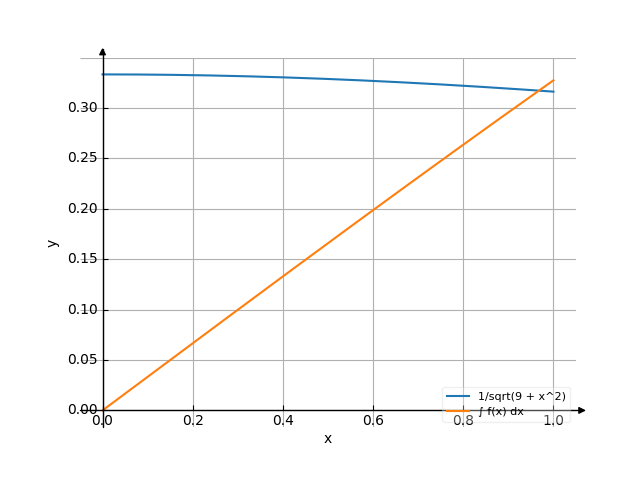Integral of 1/sqrt(9+x^2) dx
The solution
You have entered
[src]
1 / | | 1 | 1*----------- dx | ________ | / 2 | \/ 9 + x | / 0
$$\int\limits_{0}^{1} 1 \cdot \frac{1}{\sqrt{x^{2} + 9}}\, dx$$
Integral(1/sqrt(9 + x^2), (x, 0, 1))
Detail solution
-
Now simplify:
-
Add the constant of integration:
TrigSubstitutionRule(theta=_theta, func=3*tan(_theta), rewritten=sec(_theta), substep=RewriteRule(rewritten=(tan(_theta)*sec(_theta) + sec(_theta)**2)/(tan(_theta) + sec(_theta)), substep=AlternativeRule(alternatives=[URule(u_var=_u, u_func=tan(_theta) + sec(_theta), constant=1, substep=ReciprocalRule(func=_u, context=1/_u, symbol=_u), context=(tan(_theta)*sec(_theta) + sec(_theta)**2)/(tan(_theta) + sec(_theta)), symbol=_theta)], context=(tan(_theta)*sec(_theta) + sec(_theta)**2)/(tan(_theta) + sec(_theta)), symbol=_theta), context=sec(_theta), symbol=_theta), restriction=True, context=1/sqrt(x**2 + 9), symbol=x)
The answer is:
The answer (Indefinite)
[src]
/ / ________ \ | | / 2 | | 1 | / x x| | 1*----------- dx = C + log| / 1 + -- + -| | ________ \\/ 9 3/ | / 2 | \/ 9 + x | /
$${\rm asinh}\; \left({{x}\over{3}}\right)$$
The graph
The answer
[src]
asinh(1/3)
$${\rm asinh}\; \left({{1}\over{3}}\right)$$
=
=
asinh(1/3)
$$\operatorname{asinh}{\left(\frac{1}{3} \right)}$$
The graph

Use the examples entering the upper and lower limits of integration.

![Find the integral of y = f(x) = 1/sqrt(9+x²) dx (1 divide by square root of (9 plus x squared)) - with detailed solution [THERE'S THE ANSWER!] 1/sqrt(9+x^2)](/media/krcore-image-pods/176/hash/indefinite/a/87/d52968d967248d29d65b96f13fc74.png)
 Integral of x*e^(x*(-2))*dx
Integral of x*e^(x*(-2))*dx
 Integral of cot^5xdx
Integral of cot^5xdx
 Integral of 1/(x^1/3)
Integral of 1/(x^1/3)